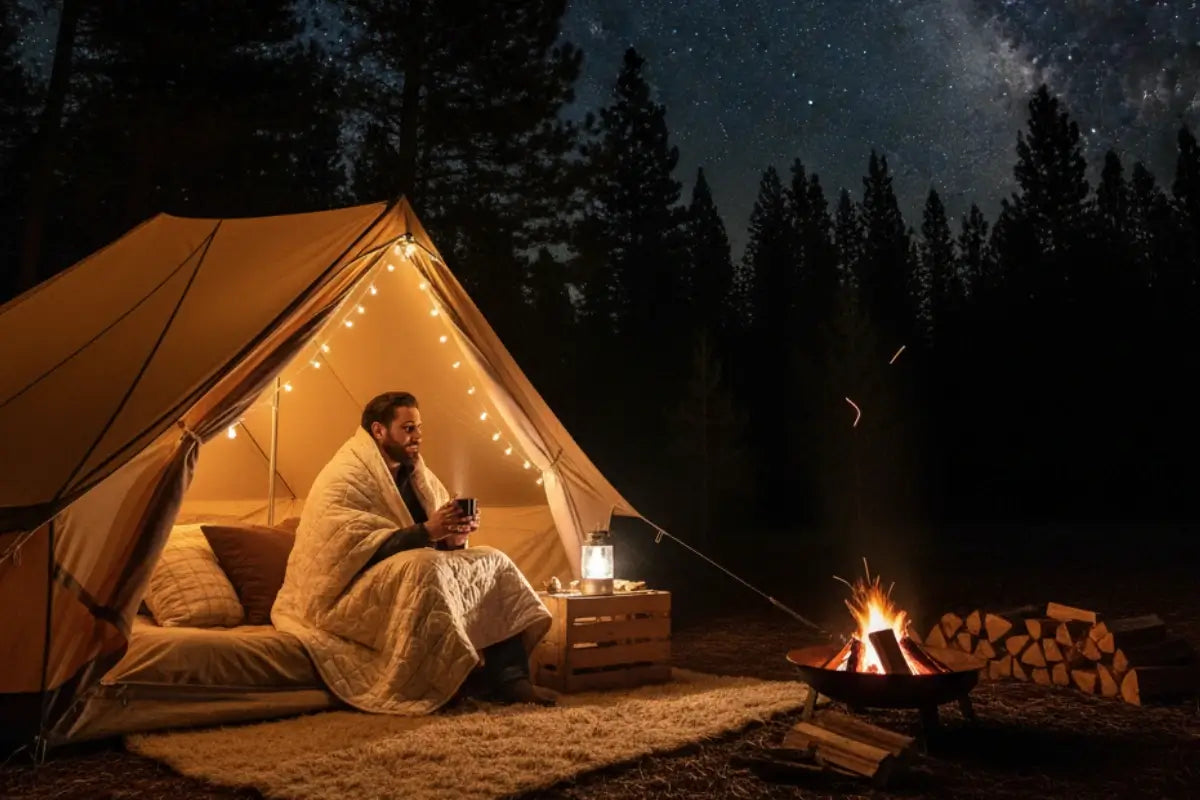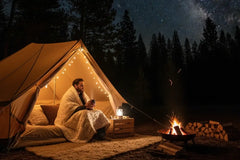Can you use heated blanket for camping?

Camping in cold weather can quickly turn fun into discomfort. A heated blanket keeps you warm, cozy, and ready to enjoy the outdoors without shivering through the night.
From battery-powered to solar and propane options, these blankets fit different needs. Knowing which type suits you makes all the difference for safe, comfortable, and worry-free camping.
Key Takeaways
Choose the Right Type: Pick between battery, USB, 12V, solar, propane, or hybrid blankets based on your camping needs.
Know Your Runtime: Expect anywhere from 3 to 13 hours of warmth, depending on blanket type, battery size, and heat settings.
Prioritize Safety: Look for certifications like UL or CE, and always inspect your blanket before use.
Match Power to Blanket: Ensure your power bank, car battery, or generator can handle the blanket’s wattage.
Stay Practical Outdoors: Opt for waterproof, outdoor-rated models and use safe surfaces to avoid hazards.
Can You Use a Heated Blanket for Camping?
Yes, you can use a heated blanket for camping, and there are several types to suit different needs.
Battery-powered and USB-heated blankets offer portability, while 12V car-powered models provide steady warmth with low energy use.
Rechargeable, solar, propane, and hybrid options add flexibility. Key factors include runtime, wattage, weight, and safety certifications, making heated blankets practical, safe, and efficient for outdoor comfort.
Types of Heated Blankets for Camping
Battery-Powered Heated Blankets
Battery-powered heated blankets are a favorite choice for campers because they combine portability with reliable warmth.
On a single charge, most models provide about 3 to 8 hours of heat, depending on settings, higher levels give quick warmth for a few hours, while lower ones can keep you cozy all evening.
Their temperature range typically falls between 100°F and 113°F (38°C–45°C), letting you choose anything from gentle warmth to a toasty feel.
How long the blanket runs also depends on battery capacity: for instance, a 100W blanket paired with a 1000Wh battery can last around 8.5 hours, factoring in efficiency loss.
Safety is equally important, and many quality blankets carry certifications like UL (Underwriters Laboratories) or CE (Conformité Européene), which ensure they meet strict safety standards for electrical performance, fire resistance, and durability.
These checks give you peace of mind, though it’s still essential to follow manufacturer guidelines for proper use and maintenance.
Altogether, battery-powered heated blankets are a practical and safe way to stay warm outdoors.
USB-Heated Blankets
USB-heated blankets are a favorite among campers because they’re lightweight, portable, and run on something as simple as a power bank.
Most models weigh between 1–2 lbs and pack down to about the size of a small pillow, making them easy to toss into your gear without much bulk.
Powered by a standard 10,000mAh power bank, these blankets can provide anywhere from 3 to 13 hours of warmth, depending on the heat setting you choose.
They usually offer three temperature levels, ranging from around 104°F (40°C) on low to 140°F (60°C) on high, with some premium options reaching up to 176°F (80°C).
Despite their efficiency, they consume very little energy, just 10–15 watts, much less than battery-powered blankets (35–60 watts) or propane heaters (700+ watts). That low draw makes them ideal for extended use in the outdoors.
On top of that, many models heat up quickly and include safety features like automatic shut-offs.
For campers wanting comfort, efficiency, and portability, USB-heated blankets are one of the most practical choices.

Rechargeable Heated Blankets
Rechargeable heated blankets are a great option for campers who want portability without being tied to a power outlet.
Most models use lithium-ion batteries, often around 10,000 mAh, which can keep you warm for 3–8 hours depending on the heat setting.
For example, the Big Hug pad heats up in just 30 seconds and lasts about three hours on its lowest setting, though higher heat drains power more quickly.
This is fine for short bursts of warmth, but not ideal if you need all-night heat. Compared to plug-in blankets, which provide endless warmth as long as they’re connected, or propane-powered ones that last as long as the fuel tank, rechargeable blankets strike a balance, lightweight, cordless, and easy to carry, but limited by battery life.
Safety is also key: look for blankets certified by UL or Intertek, check regularly for wear and tear, and avoid folding or layering them. With the right care, they’re a safe, flexible, and cozy choice for nights under the stars.

12V Car-Powered Heated Blankets
A 12V car-powered heated blanket is one of the most energy-efficient options for camping. Unlike regular electric blankets that use 200–400 watts, these only consume about 35–60 watts (roughly 3 amps), making them gentler on your vehicle’s battery.
On their highest setting, they can reach around 100–104°F (38–40°C) and usually warm up within 20–30 minutes, providing steady, comfortable heat rather than an intense burst.
If connected to a standard 12V car battery, a blanket running at about 80 watts could last close to 7 hours before draining the battery, though it’s best to monitor voltage or use a portable power station to avoid starting issues.
Safety is another strong point, most 12V heated blankets include automatic shut-off timers, built-in temperature regulators to prevent hot spots, and fire-resistant materials for peace of mind.
Altogether, they’re a practical way to stay warm outdoors without putting too much strain on your power source.
Solar-Powered Heated Blankets
Solar-powered heated blankets use built-in flexible solar panels to charge an internal battery that powers heating elements.
They can charge slowly in cloudy weather, with sunlight providing the fastest recharge. Most have adjustable heat settings, some are water-resistant, and a full charge can maintain warmth for several hours.
Propane-Heated Blankets
Propane-heated blankets use small propane cartridges to fuel an internal burner, providing hours of warmth even in extreme cold.
They require proper ventilation and occasional supervision, especially indoors or in tents. While portable, cartridge weight may limit their suitability for backpacking. They offer quick, reliable heat without electricity or sunlight.
Hybrid or Multi-Power Heated Blankets
Hybrid or multi-power heated blankets use multiple energy sources, like batteries, solar panels, and wall plugs.
They let users switch power depending on availability, making them versatile for indoor and outdoor use.
Many offer adjustable temperatures and efficient heat, ensuring warmth in unpredictable conditions.
Power Options for Heated Blankets While Camping
When camping in cold weather, a heated blanket can be a game-changer, but knowing how much power it needs and how long your portable source will last is important.
Most heated blankets use between 60–100 watts for singles and 100–200 watts for larger ones, which is far less than a space heater that can draw 1500 watts or more.
This makes them energy-friendly, but your power setup still matters. A 20,000 mAh power bank (around 150 Wh usable) might keep a 100W blanket running for 1.5–2 hours, while lower-wattage blankets on medium settings can stretch that longer.
Portable power stations provide more flexibility, depending on capacity, a 300Wh unit might run a 60W blanket for 5 hours, while a 1000Wh station could keep it going for 8 hours or more.
Battery-powered heated blankets are another option, though they typically offer less heat and shorter runtimes compared to plug-in models.
Choosing the right setup comes down to your blanket’s wattage, the battery size, and how warm you want to stay through the night.
Safety Considerations When Using Heated Blankets Outdoors
Outdoor-Rated Only: Choose blankets specifically designed and rated for outdoor use.
Waterproof Protection: Always check for waterproofing to guard against rain and moisture.
Safe Power Sources: Use only approved batteries or safe outlets to power your blanket.
Heat Control: Avoid prolonged use of high-heat settings to prevent burns.
Stable Placement: Keep blankets on flat, non-flammable surfaces to reduce hazards.
Fire Awareness: Stay alert to fire risks and always have a safety plan in mind.
Regular Inspection: Check your blanket before each use and store it in dry conditions to extend its lifespan.




